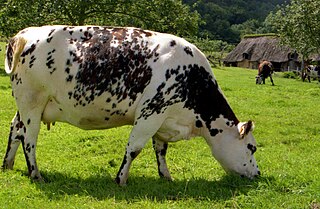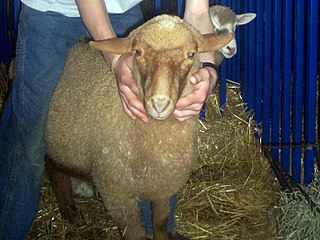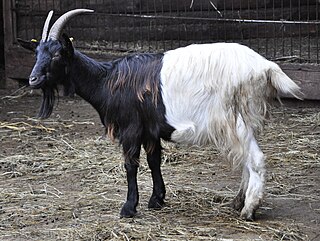
The Suffolk is a British breed of domestic sheep. It originated in the late eighteenth century in the area of Bury St. Edmunds in Suffolk, as a result of cross-breeding when Norfolk Horn ewes were put to improved Southdown rams. It is a polled, black-faced breed, and is raised primarily for its meat. It has been exported to many countries, and is among the most numerous breeds of sheep worldwide.

The Normande is a breed of dairy cattle from the Normandy region of north-west France. It is raised principally for its milk, which is high in fat and suitable for making butter and cheese, but also for its meat, which is marbled and good-flavoured. It is a world breed: it has been exported to many countries and is present on all continents.

The Pinzgauer is a breed of domestic cattle from the Pinzgau region of the federal state of Salzburg in Austria. It has distinctive colouring, with chestnut-brown sides and white back and underside. It was in the past a triple-purpose breed, raised for meat, milk and draught use. There is a naturally polled sub-type, the Jochberg Hummel. In 2007 the breed was not considered by the FAO to be at risk.

The Japanese Black is a breed of Japanese beef cattle. It is one of six native Japanese cattle breeds, and one of the four Japanese breeds known as wagyū, the others being the Japanese Brown, the Japanese Polled and the Japanese Shorthorn. All wagyū cattle derive from cross-breeding in the early twentieth century of native Japanese cattle with imported stock, mostly from Europe. In the case of the Japanese Black, the foreign influence was from European breeds including Braunvieh, Shorthorn, Devon, Simmental, Ayrshire and Holstein.

The American Tunis or Tunis is an endangered American breed of fat-tailed sheep. It derives from Tunisian Barbarin sheep imported to the United States from Tunisia in 1799. It is raised primarily for meat.

The Castlemilk Moorit is a rare breed of domestic sheep originating in Dumfriesshire in Scotland.

The Crèvecœur is an endangered historic breed of crested chicken from the Pays d'Auge, in the Calvados département of Normandy, in north-western France. It is named after the commune of Crèvecœur-en-Auge. It is related to the La Flèche and to other Norman breeds such as the Caumont and Caux and the extinct Pavilly; the Merlerault was formerly considered a sub-type of the Crèvecœur.
The Maltese is a breed of domestic goat from the east and central Mediterranean area. It originates in Asia Minor, and takes its name from the island of Malta. It is raised mainly in southern Italy, and particularly in the islands of Sicily and Sardinia. Although the Maltese: Mogħża Maltija is reported to DAD-IS, the official view is that there are no pure-bred specimens of the breed in the Maltese islands, although it is possible that some modern Maltese goats are closely related to the original type. The Maltese is also present in Greece, Turkey and the Maghreb.

The Valais Blackneck is a breed of domestic goat from the canton of Valais, in southern Switzerland, and neighbouring areas of northern Italy. The largest concentration is in the area of Visp (Viège). It is present in modest numbers in Austria and Germany. It is known by many names, including German: Walliser Schwarzhalsziege or Gletschergeiss; French: Col Noir du Valais, Chèvre des Glaciers or Race de Viège; and Italian: Vallesana or Vallese.

The Marwari is an Indian breed of domestic sheep. It originates in, and is named for, the Marwar region of south-western Rajasthan, in the north-west of India. It is reared in the five principal districts of Marwar – Barmer, Jalore, Jodhpur, Nagaur and Pali – and also in some neighbouring districts of Rajasthan and Gujarat.
The Brentegana is an Italian breed of sheep from the provinces of Trento and Verona in northern Italy. The name derives from that of the comune of Brentonico, the area where the breed is thought to have originated. Two distinct types are known: the Brentegana Scelta or Brentegana Trentina, a large heavy meat/wool type; and the Brentegana Comune, a medium-sized type more suitable for milk production. It is one of the forty-two autochthonous local sheep breeds of limited distribution for which a herdbook is kept by the Associazione Nazionale della Pastorizia, the Italian national association of sheep-breeders.
The Istriana or Carsolina, Croatian: 'Istarska Ovca', Slovene: 'Istrska Pramenka', is a breed of domestic sheep from Istria and the Karst regions of the northern Adriatic, from north-east Italy to Croatia and Slovenia.
The Barbaresca or Barbaresca Siciliana is a breed of large fat-tailed sheep from the Mediterranean island of Sicily, in southern Italy. It derives from the cross-breeding between indigenous Sicilian Pinzirita sheep with fat-tailed Barbary sheep of Maghrebi origin. These were probably brought to the island after the Muslim conquest of Sicily in the 9th century; Arabic texts preserved at Agrigento document the movement of large numbers of sheep to the Sicilian interior.
The Leccese or Moscia Leccese is a breed of domestic sheep indigenous to the Salento peninsula, in Puglia, southern Italy. Its name derives from that of Lecce, the principal city of the peninsula. Like the Pinzirita and the Altamurana, it belongs to the Zackel sheep group. It is a hardy and frugal breed, usually kept in semi-feral herds, capable of surviving year-round on pasture alone. The wool is normally white and the skin flesh-coloured with darker mottlings. In a small proportion of animals the wool is entirely black, and the skin is also black; these black-skinned sheep are resistant to the effects of the poisonous Hypericum crispum, common in the Salento, which in the white-woolled, pale-skinned sheep causes photosensitivity and thus dermatitis.
The Laticauda is a breed of domestic sheep from Campania and Calabria, in southern Italy. It is a fat-tailed breed, which gives rise to the name Laticauda, "broad-tailed". It is raised mainly in its area of origin in the provinces of Avellino, Benevento and Caserta, but is also found in the provinces of Cosenza, Matera and Naples. Like the Barbaresca breed of Sicily, it appears to result from the hybridisation of local breeds with Barbary sheep of Maghrebi origin. It has been suggested that these were first brought to the area by the Bourbon king Charles VII of Naples.

The Chamois Coloured Goat, French: Chèvre chamoisée, German: Gämsfarbige Gebirgsziege, Italian: Camosciata delle Alpi, is an indigenous breed of domestic goat from Switzerland. It is distributed throughout Switzerland and in parts of northern Italy and Austria, and has been exported to other countries including France. There are two strains, a horned type from the Grisons or Graubünden in the eastern part of the country, and a hornless type from the former bezirk of Oberhasli and the area of Brienz and Lake Brienz in the Bernese Oberland in central Switzerland. In some countries the hornless variety may be considered a separate breed, the Oberhasli goat. The Swiss herd-book was established in 1930.

The Dongola or Dongolawi is an African breed of riding horse. It is predominantly of Barb type, though there may have been some Arab influence in the past. It originated in the Dongola province of Sudan, for which it is named. In eastern Africa it is distributed in the northern part of Sudan and in western Eritrea; it is also present in several West African countries including Cameroon, Chad and the Central African Republic. A number of local West African breeds or types derive from it; they may be regarded as sub-types, or may be reported as separate breeds.

The Swedish Red-and-White, Swedish: 'Svensk Röd och Vit Boskap', frequently abbreviated to SRB, is a Swedish breed of dairy cattle. It was created in the 1920s by crossing the Swedish Red Pied and Swedish Ayrshire breeds.
The Turchessa or Turchesca is a rare Italian breed of domestic sheep. It originated on the foothills of Vesuvius, in Campania in southern Italy. It may also be known as the Pecora di Poggiomarino, for the comune of Poggiomarino in that area. Its conservation status is not clear.
Edilbay sheep, also known as Edilbaev(skaya) sheep, are a breed of domesticated sheep which originated in northern Kazakhstan. This breed belongs to the coarse-wooled fat-tailed type of sheep and the Kazakh group. It originated in the 19th century as a cross between Kazakh fat-tailed sheep and Kalmyk/Astrakhan coarse-wooled sheep. Today, it is found in Kazakhstan and Russia.














